New Forest loop (4 days- 68 miles)
This was to be more of a sightseeing trip using bikes, rather than a cycle ride from 'A' to 'B'. It wasn't many cycling miles on any of our days, in fact it was more hours of walking than cycling. There was a few things I wanted to see in the New Forest and starting from Southampton, we were going to do a loop of around Seventy miles over a few days. It's always a tough decision travelling to an area, and then deciding whether start riding on the the same day or stay and start in the morning, as the train journey itself can take several hours.
Day 1- Southampton to Holbury via Calshot (15 miles)
We caught the train to Southampton early in the day, when we got off the
train, it was a glorious warm day around lunch time. Climbing the footbridge outside the station,
 there was an interesting rut (purposely made) next to the steps to wheel bikes over without picking
them up. We passed Mayflower park on our right and could see a massive Ocean Liner in the dock, waiting
to take people on a cruise to who knows where. At the Town Quay there were medieval walls and some turrets on our left side
from the 13th century. We pulled into the ferry terminal and were forty minutes too early, so we had a coffee
and waited for the Hythe Ferry. The ferry price for adults is £4.60 and £3 each for the
bikes, and even though we managed to get on as pensioners, the total still wasn't cheap.
there was an interesting rut (purposely made) next to the steps to wheel bikes over without picking
them up. We passed Mayflower park on our right and could see a massive Ocean Liner in the dock, waiting
to take people on a cruise to who knows where. At the Town Quay there were medieval walls and some turrets on our left side
from the 13th century. We pulled into the ferry terminal and were forty minutes too early, so we had a coffee
and waited for the Hythe Ferry. The ferry price for adults is £4.60 and £3 each for the
bikes, and even though we managed to get on as pensioners, the total still wasn't cheap.
It takes about fifteen minutes to cross one of the busiest shipping ports in the World to Hythe. We disembarked onto the longest piers in the country, also boasting of the oldest continuously operating public electric tramway in the world. We were warned about the pier wooden boards heading back to shore, the planks run in a longitude manner with some gaps of more than an inch in-between. We were told to either walk or 'zig zag' back to the shore. We rode in a sinusoidal wave all the way back, but still had a few doggy moments. Hythe town is nice and has a lovely aray of Medieval and Georgian buildings. We continued on along the shore road, then onto Fawley road heading for Calshot Spit. At Calshot we turned left and followed the 'Jack Maynard' road to the Spit, with its eclectic mix of coloured beach huts on the beach, one could easily imagine Victorian's bathing in their all in one bathing suits.
 Calshot used to be a WW2 RAF flying boat base, most of the buildings are still maintained and some are
converted into dormitories for the Calshot Activities centre. We took the bikes inside the building
and just locked them up against a post. The place has a special place in my
memories as I used to train here on the indoor velodrome placed in one of old the hangers.
We popped inside their cafe and ordered a small lunch, and sat outside enjoying great food with fantastic
views over the Solent, with the sea lapping fifteen feet away from us against a pebble beach.
To walk the lunch off, we had a toddle around the area and visited Calshot castle, at a
reasonable entrance price of £3 each. Calshot Castle is one of Henry VIII's forts, and was built as a
circular blockhouse with a three storey central keep in 1540 using stone from Beaulieu Abbey.
Calshot used to be a WW2 RAF flying boat base, most of the buildings are still maintained and some are
converted into dormitories for the Calshot Activities centre. We took the bikes inside the building
and just locked them up against a post. The place has a special place in my
memories as I used to train here on the indoor velodrome placed in one of old the hangers.
We popped inside their cafe and ordered a small lunch, and sat outside enjoying great food with fantastic
views over the Solent, with the sea lapping fifteen feet away from us against a pebble beach.
To walk the lunch off, we had a toddle around the area and visited Calshot castle, at a
reasonable entrance price of £3 each. Calshot Castle is one of Henry VIII's forts, and was built as a
circular blockhouse with a three storey central keep in 1540 using stone from Beaulieu Abbey.
 It was late afternoon cycling back along the coloured beach hut road, heading for the 'Old
Mill Inn', described as a 'missing gem' of the area. Off the main road, down a short, winding lane and
there it was, a 'Hansel and Gretel' thatched cottage pub, now here is a magic place to be certain!
We entered and ordered a couple of pints of real ale, the pub has a flagstone floor and has maintained
an eighteenth century appeal. Little did I know, so did the rooms we booked (maybe a little harsh). The
bathroom was tiny and had damp mould on the walls, after complaining, they reduced the price, but don't
be put off by that, a splash of paint and there'd be no complaints. Except; their website advertised
there being food, the pub kitchens had shut years ago and had been taken over by a Thai owner, and even
they had long gone and no longer cook; they hadn't updated their website. We walked miles for food, only
to be told by the locals on our return; "you could have ordered a takeaway, they would have let you eat
it in the bar."
It was late afternoon cycling back along the coloured beach hut road, heading for the 'Old
Mill Inn', described as a 'missing gem' of the area. Off the main road, down a short, winding lane and
there it was, a 'Hansel and Gretel' thatched cottage pub, now here is a magic place to be certain!
We entered and ordered a couple of pints of real ale, the pub has a flagstone floor and has maintained
an eighteenth century appeal. Little did I know, so did the rooms we booked (maybe a little harsh). The
bathroom was tiny and had damp mould on the walls, after complaining, they reduced the price, but don't
be put off by that, a splash of paint and there'd be no complaints. Except; their website advertised
there being food, the pub kitchens had shut years ago and had been taken over by a Thai owner, and even
they had long gone and no longer cook; they hadn't updated their website. We walked miles for food, only
to be told by the locals on our return; "you could have ordered a takeaway, they would have let you eat
it in the bar."
Day 2- Holbury to Lymington via Beaulieu (20 miles)
The Old Mill Inn wasn't B&B it was just bed (exactly what we'd negotiated, as we don't like to have a cooked breakfast and ride the bike). We headed for Beaulieu, a quaint village that has remained largely unspoilt by progress. We had a light breakfast at Fairweathers garden centre, then waited for the National Motor Museum at Beaulieu to open (ten o'clock). After a short battle with the staff about storing the bikes, the manager turned up. He offered the boiler house as the only secure lock up, we agreed and thanked him. Ironically, he said he was considering getting some little bike sheds as he'd encountered this problem before.
 I'd been here before as a kid and it was well worth revisiting once more in my life, but be prepared to
be shocked by the price; it's £24 on the day (adult) or £18 advanced purchase from the internet and
note the special offer tickets must be purchased at least one day in advance of your visit. After that financial
blow we continued our visit in awe. Obviously, the cars were in mint condition and were probably worth
trillions. We had a walk around the Manor house and Abbey (still in the grounds) which was interesting, two
hours later we left. Our next destination was Bucklers Hard, an 18th century boat building community,
labeled the 'birthplace' of many British naval vessels, including many of Admiral Nelson's fleet, and
nicknamed 'Montagu Town'. To get there we rode along the Beaulieu River on a shale cycling path all the way
into Bucklers Hard, something the locals do, which negated paying another £6.50 to see the landmark.
Next was Lymington and on route we passed St Leonards Barn (free to look at, thank goodness!), an enormous
13th or 14th century barn standing by the roadside, thought to be one of the largest in England.
I'd been here before as a kid and it was well worth revisiting once more in my life, but be prepared to
be shocked by the price; it's £24 on the day (adult) or £18 advanced purchase from the internet and
note the special offer tickets must be purchased at least one day in advance of your visit. After that financial
blow we continued our visit in awe. Obviously, the cars were in mint condition and were probably worth
trillions. We had a walk around the Manor house and Abbey (still in the grounds) which was interesting, two
hours later we left. Our next destination was Bucklers Hard, an 18th century boat building community,
labeled the 'birthplace' of many British naval vessels, including many of Admiral Nelson's fleet, and
nicknamed 'Montagu Town'. To get there we rode along the Beaulieu River on a shale cycling path all the way
into Bucklers Hard, something the locals do, which negated paying another £6.50 to see the landmark.
Next was Lymington and on route we passed St Leonards Barn (free to look at, thank goodness!), an enormous
13th or 14th century barn standing by the roadside, thought to be one of the largest in England.
I rely on the accuracy of 'Google' maps or 'OpenCycleMap.org' to plan any ride. If you click 'getting around' on Google maps and then 'Bicycling', it highlights the cycle routes in the area, but in truth; some are private roads which are ferociously defended by 'keep out' or 'private road' signs. We crossed Sowley lane and came across one such sign, not wishing to offend we turned back and retraced our steps, going around the private road. Researching the subject when I got home, gave me little resolution, it was too complicated and I lost interest.
 We headed to Lymington Pier where there is another ferry across to the Isle of Wight, after a nice coffee
in the terminal waiting area, we plodded on to Lymington around the bay. The bay was full of moored
yachts and motorboats, the area obviously has money. We were staying at the 'Mayfair pub' which was
almost directly opposite where we were, but a two mile trip around the bay. The pub stands alone and
was decorated with an abundance of coloured flowers and plants, it had a great beer garden around the
back. They locked the bikes away in a shed and we went up to the room. A grand room with sea views,
after a shower we headed for the town, a five minute walk away, but stopped off at Lymington Yacht club to
have a couple of pints, we could have been in the South of France with the views. There's a
cobblestone road leading from the old Town quay, revealing a beautiful, Georgian market town. With
such an affluent area we went to Wetherspoons where the 'daily offer' beer is relatively cheap.
We headed to Lymington Pier where there is another ferry across to the Isle of Wight, after a nice coffee
in the terminal waiting area, we plodded on to Lymington around the bay. The bay was full of moored
yachts and motorboats, the area obviously has money. We were staying at the 'Mayfair pub' which was
almost directly opposite where we were, but a two mile trip around the bay. The pub stands alone and
was decorated with an abundance of coloured flowers and plants, it had a great beer garden around the
back. They locked the bikes away in a shed and we went up to the room. A grand room with sea views,
after a shower we headed for the town, a five minute walk away, but stopped off at Lymington Yacht club to
have a couple of pints, we could have been in the South of France with the views. There's a
cobblestone road leading from the old Town quay, revealing a beautiful, Georgian market town. With
such an affluent area we went to Wetherspoons where the 'daily offer' beer is relatively cheap.
Day 3- Lymington to Brockenhurst via Hurst Castle (20 miles)
 Breakfast in the Mayflower was superb and we set off a little bleary eyed from last night, heading
towards the coast, until we hit another 'permisive path' sign informing us this particular path was
restricted to walkers only. One of the locals who was walking his dog said "don't worry about it", so
we continued to Keyhaven over a lock controlling the water level in Keyhaven marshes. Our destination was
Hurst Castle via the ferry. With a head on sea breeze rode we along a sand bar with the sea on the left
and salt marshes on the right. Hurst Castle was a tiny spec in the distance, balanced on a large
mound protruding from the sea. We were pre-warned there is no road to Hurst castle, only a pebble path which
is unridable and would've been hard going pushing a laden bike along the mile long causeway. The
ferry price was £5.50 return, a bit steep, but better than going around. The
Keyhaven ferry doesn't carry bikes to Hurst Castle and at the pontoon there wasn’t anywhere to lock
them, so we retraced our steps and secured them behind Keyhaven yacht club then jumped on the
ferry.
Breakfast in the Mayflower was superb and we set off a little bleary eyed from last night, heading
towards the coast, until we hit another 'permisive path' sign informing us this particular path was
restricted to walkers only. One of the locals who was walking his dog said "don't worry about it", so
we continued to Keyhaven over a lock controlling the water level in Keyhaven marshes. Our destination was
Hurst Castle via the ferry. With a head on sea breeze rode we along a sand bar with the sea on the left
and salt marshes on the right. Hurst Castle was a tiny spec in the distance, balanced on a large
mound protruding from the sea. We were pre-warned there is no road to Hurst castle, only a pebble path which
is unridable and would've been hard going pushing a laden bike along the mile long causeway. The
ferry price was £5.50 return, a bit steep, but better than going around. The
Keyhaven ferry doesn't carry bikes to Hurst Castle and at the pontoon there wasn’t anywhere to lock
them, so we retraced our steps and secured them behind Keyhaven yacht club then jumped on the
ferry.
Hurst Castle is situated at the seaward end of the shingle spit that extends 1½ miles from Milford-On-Sea and was another £4.50 to get in. The castle is so close to the Isle of Wight, one could almost throw a stone from the castle keep and hit the island, the views are simply spectacular. We spent two hours here and went back on the ferry to Keyhaven, our next destination was 'Boldre' where there was a 11th century church. It was absolutely boiling, so we pulled into Lymington hospital and had some cold drinks before heading off down Boldre lane. Boldre church is somewhat unusual, set on a hill and well away from any village, but worth a visit. To our surprise, it had links to 'HMS Hood', a ship that sank with most of its hands during WW1.
 After this we went into the woods along a bridal path, a bit bumpy but ridable, all the way to
Brockenhurst, famous for it's roaming donkeys. In this pretty New Forest village lost in time, we
were enchanted by a Victorian thatched cottage hotel and stopped for tea. After dodging a
few waywood donkeys (and their droppings) we continued on the National cycle route two, through
the forest where we came face to face with a buzzard sat on a branch six feet away from us. After
a few minutes eyeing each other up, he gave us a nonchalant look and flew off- wow.
After this we went into the woods along a bridal path, a bit bumpy but ridable, all the way to
Brockenhurst, famous for it's roaming donkeys. In this pretty New Forest village lost in time, we
were enchanted by a Victorian thatched cottage hotel and stopped for tea. After dodging a
few waywood donkeys (and their droppings) we continued on the National cycle route two, through
the forest where we came face to face with a buzzard sat on a branch six feet away from us. After
a few minutes eyeing each other up, he gave us a nonchalant look and flew off- wow.
Now on route to Lyndhurst, heading for the Lyndhurst Park Hotel. I must say this was obviously once a grand hotel, but today we were offered a noisy front room with windows that wouldn't shut. We asked for another room and were given one that had the wallpaper hanging off, they said they didn't have another twin room so that was it as I'd already pre-paid the room, but at least the windows shut and it had a view of the swimming pool (that was dry). Again their website didn't say the pool was being refurbished, a theme we were getting very familiar with. The pool was another reason why I choose this hotel. If I'd have known the hotel was in such a bad state of repair, we wouldn't have stayed there. We took the hotel up on their offer of £22 for dinner for two with a bottle of wine. Later they tried charging £22 each, but we were having none of it. After diner we strolled around the town past a garage selling one hundred and eighty thousand pound Ferrari's and Bugatti's and into the town, we settled in the Lyndhurst Workman's club a distinct conflicting institution to the Ferrari garage. That night I believe I had food poisoning and was ill all night.
Day 4- Brockenhurst to Southampton (13 miles)
 I couldn't eat any breakfast and we had a pre-booked train to catch, so we set off. Again
'Google' shows the A35 as having a cycle path, but in truth, it's no better than a narrow garden
path. Gladly, we turned off the A35 into 'cycle friendly' roads, through a private housing estate. Near
Southampton we crossed a footbridge over the railway to get to the quays diving centre
to have a shower, after carrying the bikes over the bridge, the path didn't go anywhere. So we had
to carry them back across and find an alternative route. We gave up having a shower and had a 'French
wash' in the station toilets.
I couldn't eat any breakfast and we had a pre-booked train to catch, so we set off. Again
'Google' shows the A35 as having a cycle path, but in truth, it's no better than a narrow garden
path. Gladly, we turned off the A35 into 'cycle friendly' roads, through a private housing estate. Near
Southampton we crossed a footbridge over the railway to get to the quays diving centre
to have a shower, after carrying the bikes over the bridge, the path didn't go anywhere. So we had
to carry them back across and find an alternative route. We gave up having a shower and had a 'French
wash' in the station toilets.
The weather was fantastic, and it's such a pleasure riding in warm temperatures and two wheels are definitely better than four! Ancient woodland, heaths, pretty villages, wildlife, castles, beautiful coastline, the New Forest has it all. When booking accommodation you totally rely on the web hotel description, it would be nice for these establishments to update their websites on hotel maintenance. One can get an accurate condition of the hotel through ‘TripAdviser’, but it doesn’t tell you when the pool or kitchens are shut and this put a slight dampener on the ride. Though, despite some of the accommodation being substandard and the private road signs blocking our route; it was a good ride. The daily mileage wasn't enough, allowing us too much time drinking (no-one forced the beer down I know). Calshot was great to revisit, the National motor museum was a treat, and Hurst castle was brilliant. Even with my mystery illness, all in all it was an exceptional few days away.
-
Gallery
 Why not have a look at the gallery relating to this ride. Click the image or the title.
Why not have a look at the gallery relating to this ride. Click the image or the title. -
Hythe electric pier trams
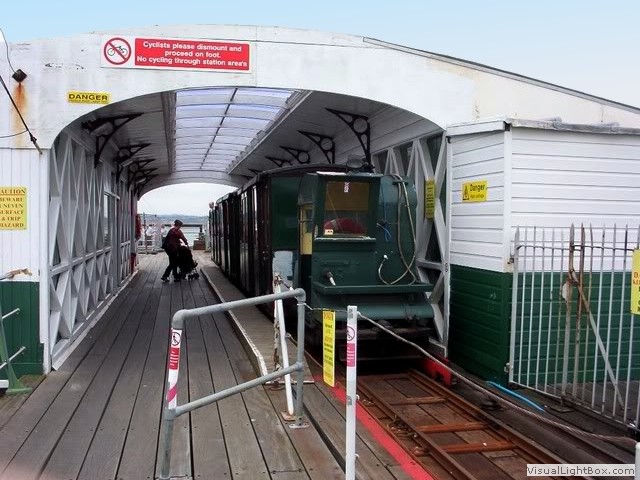 The line is operated by two four-wheeled electric locomotives built in 1917 by Brush. They were
originally battery powered, used at the World War 1 mustard gas factory at Avonmouth. They
were transferred to Hythe after the war, where they had their batteries removed and then converted
to collect power from a third rail.
The line is operated by two four-wheeled electric locomotives built in 1917 by Brush. They were
originally battery powered, used at the World War 1 mustard gas factory at Avonmouth. They
were transferred to Hythe after the war, where they had their batteries removed and then converted
to collect power from a third rail. -
The Calshot Express
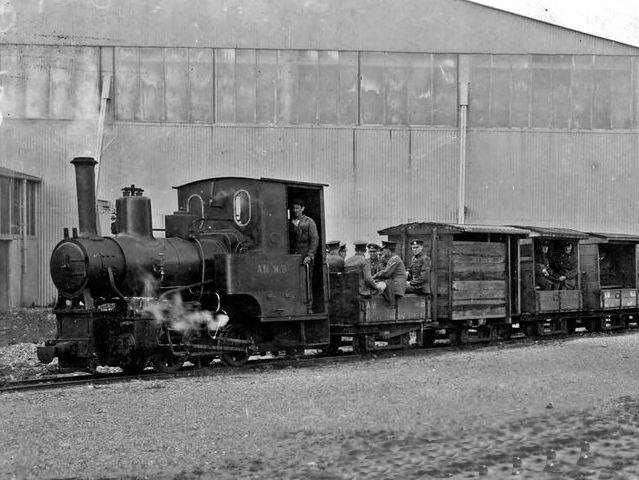 Calshot was served by a narrow gauge railway between 1919 and 1945, it transported enlisted personnel back
and forth to the accommodation blocks which were a few miles away from the camp, the officers were in
blocks right next to the hangers. It was affectionately known as the 'Calshot Express'. One of it's
steam engines is still in use on the Talylln railway in Wales.
Calshot was served by a narrow gauge railway between 1919 and 1945, it transported enlisted personnel back
and forth to the accommodation blocks which were a few miles away from the camp, the officers were in
blocks right next to the hangers. It was affectionately known as the 'Calshot Express'. One of it's
steam engines is still in use on the Talylln railway in Wales. -
Calshot Castle
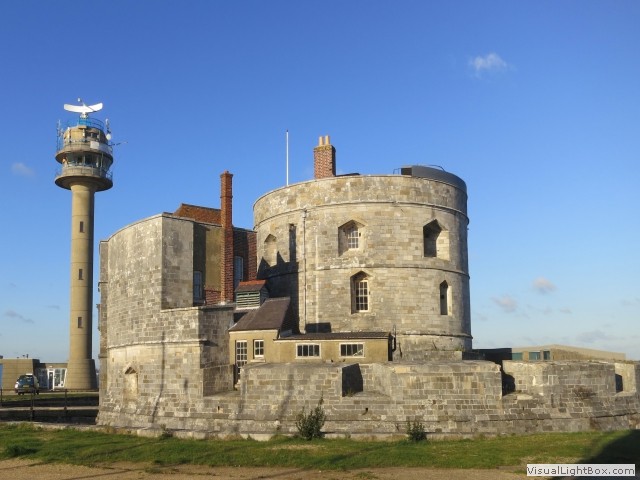 Also known as a Henrician Castle, Calshot was built as part of Henry's chain of coastal defences to
defend England's coast from foreign invasion especially during the turbulent times after his break
from the Roman Catholic Church. The outer walls were lowered in 1774 and the gatehouse was rebuilt
in order to provide more living space.
Also known as a Henrician Castle, Calshot was built as part of Henry's chain of coastal defences to
defend England's coast from foreign invasion especially during the turbulent times after his break
from the Roman Catholic Church. The outer walls were lowered in 1774 and the gatehouse was rebuilt
in order to provide more living space. -
The Old Mill Inn manifestations
 The old Mill Inn exhibits ghostly manifestations, including the earthly spirit of an old monk with a
full red beard. Where he came from is anyone's guess, as he could have served at any local monastery or
been a pilgrim. The building went up in the 15th century as a cottage and then a barn was added. The oldest
part of the Old Mill is thatched and covered with ivy. Inside, there is an inglenook fireplace with
piles of logs for cold nights.
The old Mill Inn exhibits ghostly manifestations, including the earthly spirit of an old monk with a
full red beard. Where he came from is anyone's guess, as he could have served at any local monastery or
been a pilgrim. The building went up in the 15th century as a cottage and then a barn was added. The oldest
part of the Old Mill is thatched and covered with ivy. Inside, there is an inglenook fireplace with
piles of logs for cold nights. -
Beaulieu Abbey
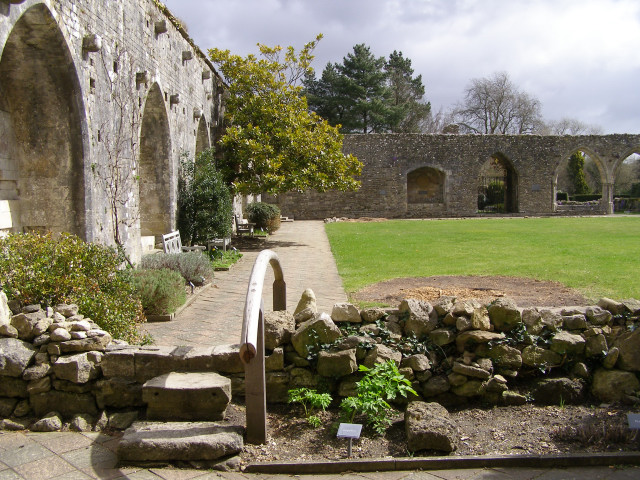 Cistercian monks founded Beaulieu Abbey in 1204 on land given to them by King John. Although much of
the Abbey was destroyed during the reign of Henry VIII with most of the stone used to build
the Beaulieu Manor house next door, south of the church still stands a cloister, arranged
around the chapter house, refectory, kitchens, storehouse and quarters for the monks.
Cistercian monks founded Beaulieu Abbey in 1204 on land given to them by King John. Although much of
the Abbey was destroyed during the reign of Henry VIII with most of the stone used to build
the Beaulieu Manor house next door, south of the church still stands a cloister, arranged
around the chapter house, refectory, kitchens, storehouse and quarters for the monks. -
HMS Agamemnon
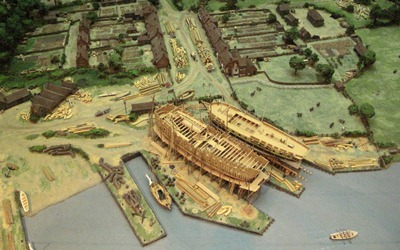 Lord Nelson's favourite ship, HMS Agamemnon was built at Buckler's Hard. She saw service in the American
Revolutionary, French Revolutionary and Napoleonic Wars at the Battle of Trafalgar as did two other
ships that were also built here, the 'Swiftsure' and the 'Euryalus'. Despite Nelson's fondness for the
ship, she was frequently in need of repair and refitting, and would likely have been hulked or scrapped
in 1802 had war with France not recommenced.
Lord Nelson's favourite ship, HMS Agamemnon was built at Buckler's Hard. She saw service in the American
Revolutionary, French Revolutionary and Napoleonic Wars at the Battle of Trafalgar as did two other
ships that were also built here, the 'Swiftsure' and the 'Euryalus'. Despite Nelson's fondness for the
ship, she was frequently in need of repair and refitting, and would likely have been hulked or scrapped
in 1802 had war with France not recommenced. -
Lymington not so Roman baths
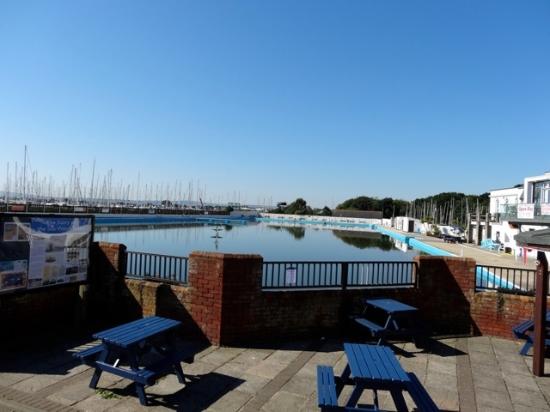 The historic Seawater Baths in Lymington are not Roman as led to believe, they were built in 1833 and
labelled as Roman as Lymington had a Roman settlement that may have had public baths. The attraction is,
however, the oldest lido in the UK. It's also one of the largest, capable of holding up to 1.7
million gallons of chlorinated seawater.
The historic Seawater Baths in Lymington are not Roman as led to believe, they were built in 1833 and
labelled as Roman as Lymington had a Roman settlement that may have had public baths. The attraction is,
however, the oldest lido in the UK. It's also one of the largest, capable of holding up to 1.7
million gallons of chlorinated seawater. -
Keyhaven Salt Production
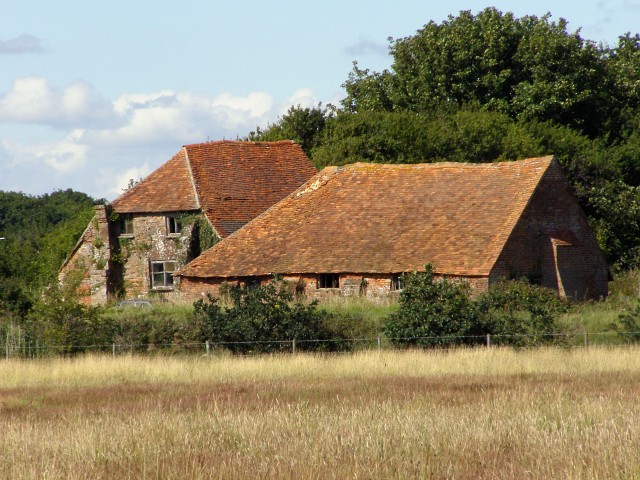 From the Middle Ages the production of sea salt was important in this area. The Lymington-Keyhaven
Nature Reserves contains the best preserved examples of medieval and later salt workings in southern
England. Salt was made by impounding seawater in shallow lagoons, known as salterns where it was left
to evaporate. Wind pumps were then used to draw off the brine solution into large metal pans where it
was heated until only the salt remained. Salt was produced here until 1865, when cheaper mined salt
from Cheshire forced the closure of the last saltern.
From the Middle Ages the production of sea salt was important in this area. The Lymington-Keyhaven
Nature Reserves contains the best preserved examples of medieval and later salt workings in southern
England. Salt was made by impounding seawater in shallow lagoons, known as salterns where it was left
to evaporate. Wind pumps were then used to draw off the brine solution into large metal pans where it
was heated until only the salt remained. Salt was produced here until 1865, when cheaper mined salt
from Cheshire forced the closure of the last saltern. -
Hurst Lighthouse
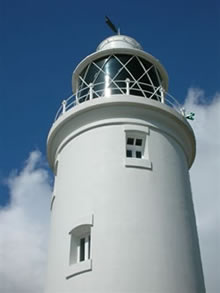 Have you ever wondered why remote lighthouses had traditionally three lighthouse keepers? It was once
not the case. The three lighthouse keeper policy was only introduced after a tragic and gruesome event
that happened at the original Smalls light house in the Irish sea, in the winter of 1800. A two man crew
manned the lighthouse but didn't get on, one accidentally died but they were not due to be relieved for
another three months, by the time the relief boat came, the surviving man went mad having to live with the rotting
corpse of his colleague.
Have you ever wondered why remote lighthouses had traditionally three lighthouse keepers? It was once
not the case. The three lighthouse keeper policy was only introduced after a tragic and gruesome event
that happened at the original Smalls light house in the Irish sea, in the winter of 1800. A two man crew
manned the lighthouse but didn't get on, one accidentally died but they were not due to be relieved for
another three months, by the time the relief boat came, the surviving man went mad having to live with the rotting
corpse of his colleague. -
Forest deer poaching
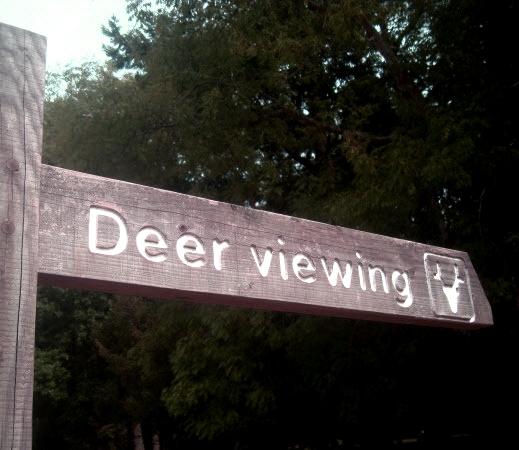 Under the harsh Forest Law those found guilty of killing the King's deer could be sentenced to death,
even if it was to feed their hungry families. Firing at or disturbing deer could lead to mutilation by
blinding or having a hand cut off. It was an offence to carry any weapons such as bows, which could be
used for hunting, and dogs that were large enough to chase deer were required by law to be 'expedited',
which meant that owners were commanded to amputate the pad and several toes of their dog's feet. There
is even an instrument known as Rufus Stirrup, hanging in the Verderer's Court at Lyndhurst, which was
traditionally used to measure dogs height.
Under the harsh Forest Law those found guilty of killing the King's deer could be sentenced to death,
even if it was to feed their hungry families. Firing at or disturbing deer could lead to mutilation by
blinding or having a hand cut off. It was an offence to carry any weapons such as bows, which could be
used for hunting, and dogs that were large enough to chase deer were required by law to be 'expedited',
which meant that owners were commanded to amputate the pad and several toes of their dog's feet. There
is even an instrument known as Rufus Stirrup, hanging in the Verderer's Court at Lyndhurst, which was
traditionally used to measure dogs height. -
Southampton station
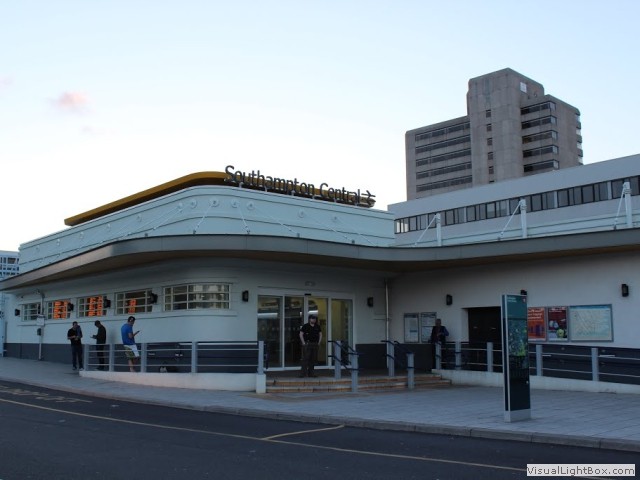 An air raid during 1940
damaged the station buildings, which were rebuilt in the fifties. After over half a century of use the station went
through an extensive refurbishment, restoring its post war 'arte deco' look.
An air raid during 1940
damaged the station buildings, which were rebuilt in the fifties. After over half a century of use the station went
through an extensive refurbishment, restoring its post war 'arte deco' look.

 The line is operated by two four-wheeled electric locomotives built in 1917 by Brush. They were
originally battery powered, used at the World War 1 mustard gas factory at Avonmouth. They
were transferred to Hythe after the war, where they had their batteries removed and then converted
to collect power from a third rail.
The line is operated by two four-wheeled electric locomotives built in 1917 by Brush. They were
originally battery powered, used at the World War 1 mustard gas factory at Avonmouth. They
were transferred to Hythe after the war, where they had their batteries removed and then converted
to collect power from a third rail. Calshot was served by a narrow gauge railway between 1919 and 1945, it transported enlisted personnel back
and forth to the accommodation blocks which were a few miles away from the camp, the officers were in
blocks right next to the hangers. It was affectionately known as the 'Calshot Express'. One of it's
steam engines is still in use on the Talylln railway in Wales.
Calshot was served by a narrow gauge railway between 1919 and 1945, it transported enlisted personnel back
and forth to the accommodation blocks which were a few miles away from the camp, the officers were in
blocks right next to the hangers. It was affectionately known as the 'Calshot Express'. One of it's
steam engines is still in use on the Talylln railway in Wales. Also known as a Henrician Castle, Calshot was built as part of Henry's chain of coastal defences to
defend England's coast from foreign invasion especially during the turbulent times after his break
from the Roman Catholic Church. The outer walls were lowered in 1774 and the gatehouse was rebuilt
in order to provide more living space.
Also known as a Henrician Castle, Calshot was built as part of Henry's chain of coastal defences to
defend England's coast from foreign invasion especially during the turbulent times after his break
from the Roman Catholic Church. The outer walls were lowered in 1774 and the gatehouse was rebuilt
in order to provide more living space. The old Mill Inn exhibits ghostly manifestations, including the earthly spirit of an old monk with a
full red beard. Where he came from is anyone's guess, as he could have served at any local monastery or
been a pilgrim. The building went up in the 15th century as a cottage and then a barn was added. The oldest
part of the Old Mill is thatched and covered with ivy. Inside, there is an inglenook fireplace with
piles of logs for cold nights.
The old Mill Inn exhibits ghostly manifestations, including the earthly spirit of an old monk with a
full red beard. Where he came from is anyone's guess, as he could have served at any local monastery or
been a pilgrim. The building went up in the 15th century as a cottage and then a barn was added. The oldest
part of the Old Mill is thatched and covered with ivy. Inside, there is an inglenook fireplace with
piles of logs for cold nights. Cistercian monks founded Beaulieu Abbey in 1204 on land given to them by King John. Although much of
the Abbey was destroyed during the reign of Henry VIII with most of the stone used to build
the Beaulieu Manor house next door, south of the church still stands a cloister, arranged
around the chapter house, refectory, kitchens, storehouse and quarters for the monks.
Cistercian monks founded Beaulieu Abbey in 1204 on land given to them by King John. Although much of
the Abbey was destroyed during the reign of Henry VIII with most of the stone used to build
the Beaulieu Manor house next door, south of the church still stands a cloister, arranged
around the chapter house, refectory, kitchens, storehouse and quarters for the monks. Lord Nelson's favourite ship, HMS Agamemnon was built at Buckler's Hard. She saw service in the American
Revolutionary, French Revolutionary and Napoleonic Wars at the Battle of Trafalgar as did two other
ships that were also built here, the 'Swiftsure' and the 'Euryalus'. Despite Nelson's fondness for the
ship, she was frequently in need of repair and refitting, and would likely have been hulked or scrapped
in 1802 had war with France not recommenced.
Lord Nelson's favourite ship, HMS Agamemnon was built at Buckler's Hard. She saw service in the American
Revolutionary, French Revolutionary and Napoleonic Wars at the Battle of Trafalgar as did two other
ships that were also built here, the 'Swiftsure' and the 'Euryalus'. Despite Nelson's fondness for the
ship, she was frequently in need of repair and refitting, and would likely have been hulked or scrapped
in 1802 had war with France not recommenced. The historic Seawater Baths in Lymington are not Roman as led to believe, they were built in 1833 and
labelled as Roman as Lymington had a Roman settlement that may have had public baths. The attraction is,
however, the oldest lido in the UK. It's also one of the largest, capable of holding up to 1.7
million gallons of chlorinated seawater.
The historic Seawater Baths in Lymington are not Roman as led to believe, they were built in 1833 and
labelled as Roman as Lymington had a Roman settlement that may have had public baths. The attraction is,
however, the oldest lido in the UK. It's also one of the largest, capable of holding up to 1.7
million gallons of chlorinated seawater. From the Middle Ages the production of sea salt was important in this area. The Lymington-Keyhaven
Nature Reserves contains the best preserved examples of medieval and later salt workings in southern
England. Salt was made by impounding seawater in shallow lagoons, known as salterns where it was left
to evaporate. Wind pumps were then used to draw off the brine solution into large metal pans where it
was heated until only the salt remained. Salt was produced here until 1865, when cheaper mined salt
from Cheshire forced the closure of the last saltern.
From the Middle Ages the production of sea salt was important in this area. The Lymington-Keyhaven
Nature Reserves contains the best preserved examples of medieval and later salt workings in southern
England. Salt was made by impounding seawater in shallow lagoons, known as salterns where it was left
to evaporate. Wind pumps were then used to draw off the brine solution into large metal pans where it
was heated until only the salt remained. Salt was produced here until 1865, when cheaper mined salt
from Cheshire forced the closure of the last saltern. Have you ever wondered why remote lighthouses had traditionally three lighthouse keepers? It was once
not the case. The three lighthouse keeper policy was only introduced after a tragic and gruesome event
that happened at the original Smalls light house in the Irish sea, in the winter of 1800. A two man crew
manned the lighthouse but didn't get on, one accidentally died but they were not due to be relieved for
another three months, by the time the relief boat came, the surviving man went mad having to live with the rotting
corpse of his colleague.
Have you ever wondered why remote lighthouses had traditionally three lighthouse keepers? It was once
not the case. The three lighthouse keeper policy was only introduced after a tragic and gruesome event
that happened at the original Smalls light house in the Irish sea, in the winter of 1800. A two man crew
manned the lighthouse but didn't get on, one accidentally died but they were not due to be relieved for
another three months, by the time the relief boat came, the surviving man went mad having to live with the rotting
corpse of his colleague. Under the harsh Forest Law those found guilty of killing the King's deer could be sentenced to death,
even if it was to feed their hungry families. Firing at or disturbing deer could lead to mutilation by
blinding or having a hand cut off. It was an offence to carry any weapons such as bows, which could be
used for hunting, and dogs that were large enough to chase deer were required by law to be 'expedited',
which meant that owners were commanded to amputate the pad and several toes of their dog's feet. There
is even an instrument known as Rufus Stirrup, hanging in the Verderer's Court at Lyndhurst, which was
traditionally used to measure dogs height.
Under the harsh Forest Law those found guilty of killing the King's deer could be sentenced to death,
even if it was to feed their hungry families. Firing at or disturbing deer could lead to mutilation by
blinding or having a hand cut off. It was an offence to carry any weapons such as bows, which could be
used for hunting, and dogs that were large enough to chase deer were required by law to be 'expedited',
which meant that owners were commanded to amputate the pad and several toes of their dog's feet. There
is even an instrument known as Rufus Stirrup, hanging in the Verderer's Court at Lyndhurst, which was
traditionally used to measure dogs height. 